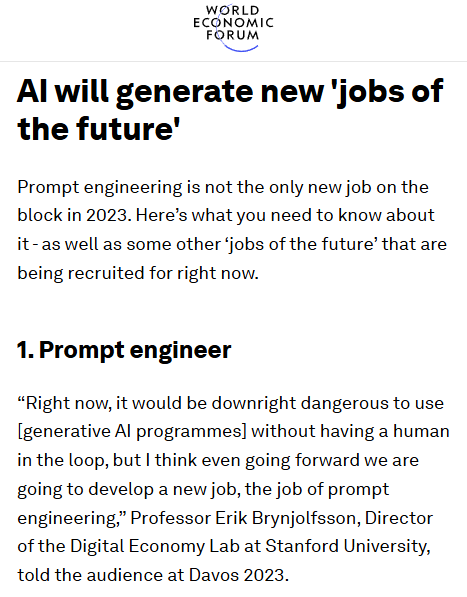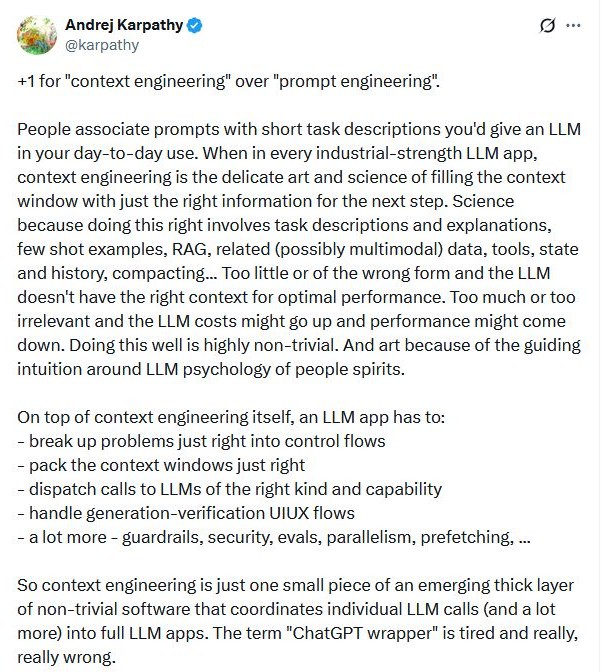MCP: Model Context Protocol
Sexiest Job of the 21st Century

Even sexier!

Context Engineer

This context thing seems important…
Retrieval-Augmented Generation (RAG)
The idea of retrieval-augmented generation is to provide the model with additional context from external sources, such as databases or documents, to improve its responses.
<<< User query >>>
<<< LIST OF TASKS >>>
User: List my tasksFunction calling
<<< User query >>>
<<< FUNCTIONS >>>
You can call functions:
- `list_open_tasks(user)`: Retrieves list of tasks
- `create_task(user, task_name, due_date)`: Creates a new task
- `mark_task_complete(user, task_id)`: Marks a task as complete
- `delete_task(user, task_id)`: Deletes a task
<<< END FUNCTIONS >>>Metaprompt
<METAPROMPT>
Given the user query:
</METAPROMPT>
"List my tasks"
<<< FUNCTIONS >>>
You can call functions:
- `list_open_tasks(user)`: Retrieves list of tasks
- `create_task(user, task_name, due_date)`: Creates a new task
- `mark_task_complete(user, task_id)`: Marks a task as complete
- `delete_task(user, task_id)`: Deletes a task
<<< END FUNCTIONS >>>
<METAPROMPT>
Choose the appropriate function to call and replace the
functions section by its results
</METAPROMPT>Model Context Protocol (MCP)
MCP is a protocol that helps applications automatically provide context to AI models.
If an application provides information using this protocol through an MCP server, an AI model that implements an MCP client can interact with the application more easily and predictably.
MCP Server:
Resources, Prompts and Tools
An MCP server exposes three types of information:
Resources: static or slow-changing documents
Prompts: Developer-tested, tuned prompts
Tools: Actions that the model can trigger
MCP Client: tools as functions
An MCP client consumes the context provided by an MCP server. Function-calling chatbots (e.g., Claude Desktop) are good examples of MCP clients, but you can write your own.
Some AI frameworks, like LangChain and Microsoft Semantic Kernel make it easy to build MCP clients.
Today, most MCP clients consume tools as functions and don’t yet do a good job with resources and prompts.
Metaprompt
MCP tools come here
The MCP Ecosystem
MCP Servers Repository
https://github.com/modelcontextprotocol/servers
- FileSystem
- YouTube Video Summarizer
- Microsoft Dataverse
- GitHub (a lot of vibecoding depends on it)
- There are even MCP servers to find MCP Servers

Agents and Vibecoding
MCP servers enable agents to access a wide range of tools and resources, making it easier to build complex workflows. One specific type of agentic behavior enabled by MCP is vibecoding, which involves using the context provided by MCP servers to generate more relevant and accurate code snippets.

This seems powerful

The To-Do MCP Server
Server code (1/2)
mcp = FastMCP("ms-todo")
@mcp.tool(description="List all open to-do tasks that the user has")
def list_open_tasks() -> list[TodoItem]:
mstd = MicrosoftToDo()
return mstd.list_open_tasks()
@mcp.tool(description="Create a new to-do task",)
def create_task(
task_name: Annotated[str,
Field(description="The name of the task")],
due_date: Annotated[datetime | None,
Field(description="The due date of the task")] = None
) -> TodoItem | None:
mstd = MicrosoftToDo()
return mstd.create_task(task_name=task_name, due_date=due_date)Server code (2/2)
Semantic Kernel MCP Client (1/2)
async def main():
kernel = Kernel()
kernel.add_service(
OpenAIChatCompletion(
ai_model_id="gpt-4.1",
service_id="default",
api_key=os.getenv("OPENAI_API_KEY")
)
)
thread = ChatHistoryAgentThread()
mcp_plugin = MCPSsePlugin(
name="LocalMCP",
url="http://localhost:9000/sse"
)
await mcp_plugin.connect()Semantic Kernel MCP Client (2/2)
agent = ChatCompletionAgent(
service=kernel.get_service("default"),
name="MCPChatbot",
instructions="You are a helpful assistant using MCP tools.",
plugins=[mcp_plugin]
)
print("MCP‑backed chatbot is ready. Type 'exit' to quit.")
while True:
user_input = await asyncio.to_thread(input, "\nYou: ")
if user_input.strip().lower() in {"exit", "quit"}:
break
response = await agent.get_response(user_input, thread=thread)
print(f"Bot: {response}")
thread = response.threadProblems

Thank you
Lucas A. Meyer
LinkedIn: lucasameyer
Threads/IG: lucas_a_meyer